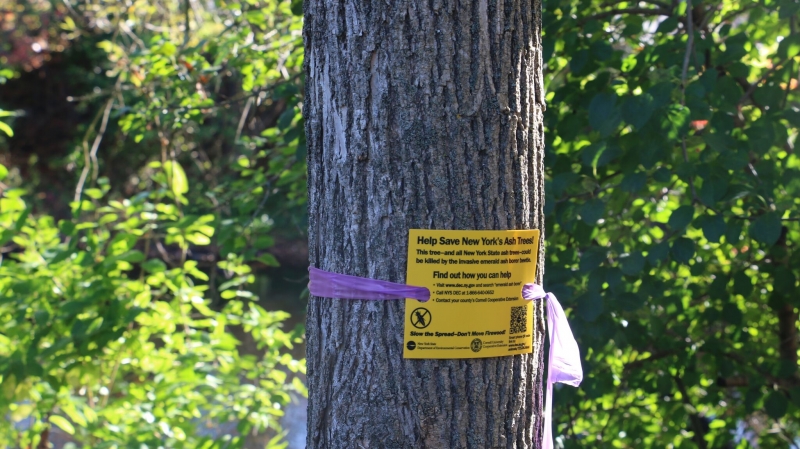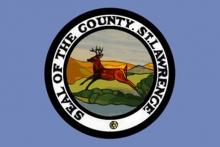
Yellow DEC signs like this one at Heritage Park in Canton ask concerned citizens to report any signs of emerald ash borers to local authorities.
Emerald Ash Borer: Getting Your Community Ready
New York State has over 900 million ash trees. They line our streets, they shade our parks, and they’re in our yards. What would happen if those 900 million ash trees, 7% of all the trees in the state, died in only a few years?
Dead and dying ash trees can collapse spontaneously and without provocation, causing hazard to people and structures nearby. Many consider widespread ash death inevitable, thanks to a tiny invasive beetle species that just reached St. Lawrence County last summer. The Emerald Ash Borer (EAB), as its name suggests, is a beautiful glittering green beetle with a shimmering copper underside. The EAB was first detected in Michigan in 2002, believed to have hitched a ride from China in hardwood packing material. It will spread on its own, but the speed of its spread is attributed to the movement of timber and firewood for human use. In its native ecosystem, EAB is benign. In the U.S., with no means of controlling its population, EAB is expected to wipe out 80% of all species of Ash trees in a matter of decades.
Communities are now faced with a decision: remove trees pre-emptively to reduce safety risks or wait for the condition of trees to deteriorate (known as the Slow Ash Mortality- SLAM- approach), knowing that removal resources may be strained when local infestation becomes apparent. It is worth noting that by the time one can easily see an infestation, it is already too late to save the tree. By that time, the adult beetle has already bored its way through the bark and laid thousands of eggs. The larvae have fed on the inside of the tree, destroying connective tissue and leaving S-shaped galleries in their wake. Only then do the young adults bore their way out of the tree, leaving D-shaped exit holes in a tree that has almost no chance left of survival. By the time these exit holes appear, the larvae have been limiting the tree’s ability to transport nutrients for years. Many trees die as quickly as one or two years after infestation.
Pesticides are available but they are costly and removal may still be necessary if the treatment does not work. So what are we to do? It’s up to individual communities to decide. There is no one-size-fits all or “best” solution. Ash trees hold different value in different places. In many communities, ash trees are shade trees that provide aesthetic value, increasing quality of life for residents and benefitting tourism. Ash was a popular choice for street trees after the blight of chestnut and elm as they stand up well to traffic exhaust and road salt. Now, they’re everywhere.
So then, what to do about EAB? The answer, of course, depends on the tree- its value, its health, its risk. Is it near a house, a road or a power line? Pre-emptive removal. Is it an old beautiful tree, one of only a few in a community park? Treat it with pesticides, if you can afford to. Is it in the middle of a wood lot? Let it be.
All of the options are costly, especially considering the need for replacement trees. In small towns throughout St. Lawrence County, citizen science has been key in developing and planning responses to EAB. Slowing the spread is important to give communities more time to prepare. There are a lot of them. They are valuable to communities. They are going to be expensive to deal with. The point is, action must be taken and those actions require planning. Even a basic EAB preparedness plan is contingent upon a decent ash tree inventory. Communities may choose to contract out an inventory. However, volunteers with very basic identification skills are also able to produce a sufficient inventory.
You can help! Nature Up North is creating a digital map of ash trees that anyone can add to. Learn to identify EAB, and help build the database by adding your trees, or encouraging friends and family to participate. To learn more, go to www.natureupnorth.org/emeraldashborer, and to add a tree to the map, visit www.natureupnorth.org/surveyashtrees.
Cornell University responded to the threat of EAB by producing the New York State EAB Community Preparedness Plan Development Workbook: https://www.dec.ny.gov/docs/lands_forests_pdf/eabplanwkbk.pdf . This workbook is a comprehensive guide to lead communities through the process of creating their own plan. Ask your Town Board and /or local officials how they are preparing your community for EAB.
Cornell Cooperative and Nature Up North are hosting a Monitoring and Managing Ash Training Workshop at Nicandri Nature Center on August 2nd. Jonathan Rosenthal, Director of the Ecological Research Institute, and senior scientist Dr. Radka Wildova, both experts in EAB ecology and management, will teach the workshop. The event is free and open to the the public, but class size is limited, so pre-registration is required. To pre-register or for workshop information, call (315) 379-9192 extension 232 or send an email to Paul Hetzler at ph59@cornell.edu.

